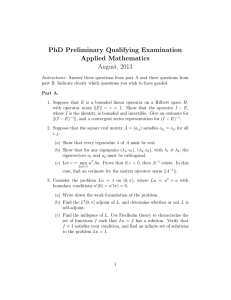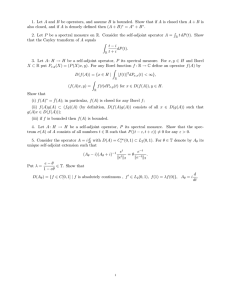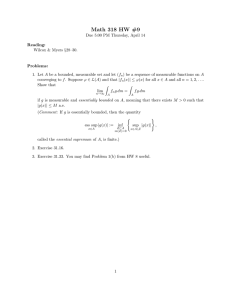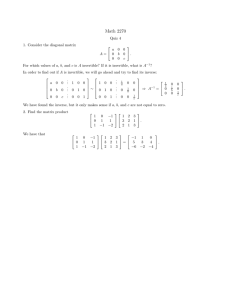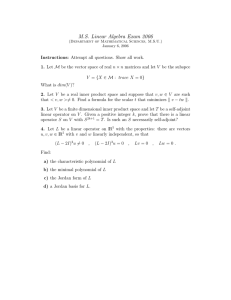16. Spectral theorem as the set (16.1)
advertisement
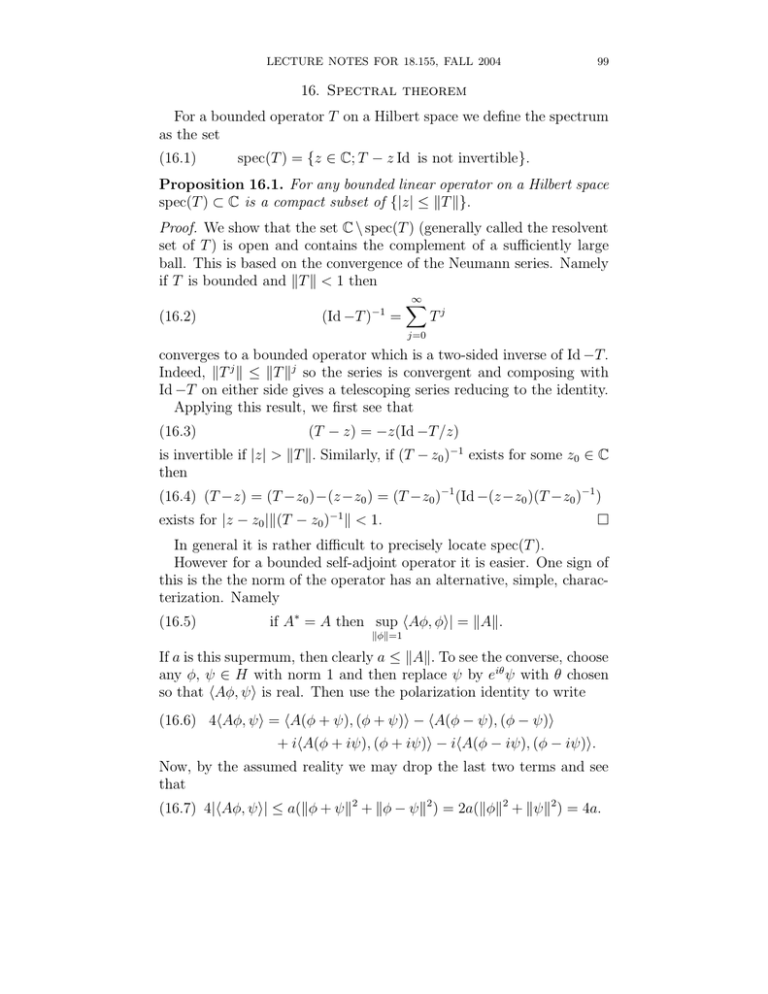
LECTURE NOTES FOR 18.155, FALL 2004
99
16. Spectral theorem
For a bounded operator T on a Hilbert space we define the spectrum
as the set
(16.1)
spec(T ) = {z ⊂ C; T − z Id is not invertible}.
Proposition 16.1. For any bounded linear operator on a Hilbert space
spec(T ) � C is a compact subset of {|z| ∪ �T �}.
Proof. We show that the set C \ spec(T ) (generally called the resolvent
set of T ) is open and contains the complement of a sufficiently large
ball. This is based on the convergence of the Neumann series. Namely
if T is bounded and �T � < 1 then
�
−1
(16.2)
(Id −T ) =
Tj
j=0
converges to a bounded operator which is a two-sided inverse of Id −T.
Indeed, �T j � ∪ �T �j so the series is convergent and composing with
Id −T on either side gives a telescoping series reducing to the identity.
Applying this result, we first see that
(16.3)
(T − z) = −z(Id −T /z)
is invertible if |z| > �T �. Similarly, if (T − z0 )−1 exists for some z0 ⊂ C
then
(16.4) (T −z) = (T −z0 )−(z −z0 ) = (T −z0 )−1 (Id −(z −z0 )(T −z0 )−1 )
exists for |z − z0 |�(T − z0 )−1 � < 1.
�
In general it is rather difficult to precisely locate spec(T ).
However for a bounded self-adjoint operator it is easier. One sign of
this is the the norm of the operator has an alternative, simple, charac­
terization. Namely
(16.5)
if A� = A then sup ∞A�, �⇒| = �A�.
∗�∗=1
If a is this supermum, then clearly a ∪ �A�. To see the converse, choose
any �, � ⊂ H with norm 1 and then replace � by ei� � with � chosen
so that ∞A�, �⇒ is real. Then use the polarization identity to write
(16.6) 4∞A�, �⇒ = ∞A(� + �), (� + �)⇒ − ∞A(� − �), (� − �)⇒
+ i∞A(� + i�), (� + i�)⇒ − i∞A(� − i�), (� − i�)⇒.
Now, by the assumed reality we may drop the last two terms and see
that
(16.7) 4|∞A�, �⇒| ∪ a(�� + ��2 + �� − ��2 ) = 2a(���2 + ���2 ) = 4a.
100
RICHARD B. MELROSE
Thus indeed �A� = sup∗�∗=∗�∗=1 |∞A�, �⇒| = a.
We can always subtract a real constant from A so that A∞ = A − t
satisfies
(16.8)
− inf ∞A∞ �, �⇒ = sup ∞A∞ �, �⇒ = �A∞ �.
∗�∗=1
∗�∗=1
Then, it follows that A∞ ± �A∞ � is not invertible. Indeed, there exists a
sequence �n , with ��n � = 1 such that ∞(A∞ − �A∞ �)�n , �n ⇒ � 0. Thus
(16.9)
�(A∞ −�A∞ �)�n �2 = −2∞A∞ �n , �n ⇒+�A∞ �n �2 +�A∞ �2 ∪ −2∞A∞ �n , �n ⇒+2�A∞ �2 � 0.
This shows that A∞ − �A∞ � cannot be invertible and the same argument
works for A∞ + �A∞ �. For the original operator A if we set
(16.10)
m = inf ∞A�, �⇒ M = sup ∞A�, �⇒
∗�∗=1
∗�∗=1
then we conclude that neither A − m Id nor A − M Id is invertible and
�A� = max(−m, M ).
Proposition 16.2. If A is a bounded self-adjoint operator then, with
m and M defined by (16.10),
(16.11)
{m} � {M } � spec(A) � [m, M ].
Proof. We have already shown the first part, that m and M are in
the spectrum so it remains to show that A − z is invertible for all
z ⊂ C \ [m, M ].
Using the self-adjointness
(16.12)
Im∞(A − z)�, �⇒ = − Im z���2 .
This implies that A − z is invertible if z ⊂ C \ R. First it shows that
(A − z)� = 0 implies � = 0, so A − z is injective. Secondly, the range is
closed. Indeed, if (A − z)�n � � then applying (16.12) directly shows
that ��n � is bounded and so can be replaced by a weakly convergent
subsequence. Applying (16.12) again to �n − �m shows that the se­
quence is actually Cauchy, hence convergens to � so (A − z)� = � is in
the range. Finally, the orthocomplement to this range is the null space
of A� − z̄, which is also trivial, so A − z is an isomorphism and (16.12)
also shows that the inverse is bounded, in fact
1
(16.13)
�(A − z)−1 � ∪
.
| Im z|
When z ⊂ R we can replace A by A∞ satisfying (16.8). Then we have
to show that A∞ − z is inverible for |z| > �A�, but that is shown in the
proof of Proposition 16.1.
�
LECTURE NOTES FOR 18.155, FALL 2004
101
The basic estimate leading to the spectral theorem is:
Proposition 16.3. If A is a bounded self-adjoint operator and p is a
real polynomial in one variable,
(16.14)
p(t) =
N
c i ti , c N =
� 0,
i=0
then p(A) =
N
�
ci Ai satisfies
i=0
(16.15)
�p(A)� ∪ sup |p(t)|.
t�[m,M ]
Proof. Clearly, p(A) is a bounded self-adjoint operator. If s ⊂
/ p([m, M ])
then p(A) − s is invertible. Indeed, the roots of p(t) − s must cannot
lie in [m.M ], since otherwise s ⊂ p([m, M ]). Thus, factorizing p(s) − t
we have
(16.16)
N
�
p(t) − s = cN
(t − ti (s)), ti (s) ⊂
/ [m, M ] =≤ (p(A) − s)−1 exists
i=1
since p(A) = cN
�
(A − ti (s)) and each of the factors is invertible.
i
Thus spec(p(A)) � p([m, M ]), which is an interval (or a point), and
from Proposition 16.3 we conclude that �p(A)� ∪ sup p([m, M ]) which
�
is (16.15).
Now, reinterpreting (16.15) we have a linear map
(16.17)
P(R) � p ∈−� p(A) ⊂ B(H)
from the real polynomials to the bounded self-adjoint operators which
is continuous with respect to the supremum norm on [m, M ]. Since
polynomials are dense in continuous functions on finite intervals, we
see that (16.17) extends by continuity to a linear map
(16.18)
C([m, M ]) � f ∈−� f (A) ⊂ B(H), �f (A)� ∪ �f �[m,M ] , f g(A) = f (A)g(A)
where the multiplicativity follows by continuity together with the fact
that it is true for polynomials.
Now, consider any two elements �, � ⊂ H. Evaluating f (A) on � and
pairing with � gives a linear map
(16.19)
C([m, M ]) � f ∈−� ∞f (A)�, �⇒ ⊂ C.
This is a linear functional on C([m, M ]) to which we can apply the Riesz
representatin theorem and conclude that it is defined by integration
102
RICHARD B. MELROSE
against a unique Radon measure µ�,� :
�
(16.20)
∞f (A)�, �⇒ =
f dµ�,� .
[m,M ]
The total mass |µ�,� | of this measure is the norm of the functional.
Since it is a Borel measure, we can take the integral on −→, b] for any
b ⊂ R ad, with the uniqueness, this shows that we have a continuous
sesquilinear map
(16.21)
�
Pb (�, �) : H×H � (�, �) ∈−�
dµ�,� ⊂ R, |Pb (�, �)| ∪ �A�������.
[m,b]
From the Hilbert space Riesz representation theorem it follows that
this sesquilinear form defines, and is determined by, a bounded linear
operator
(16.22)
Pb (�, �) = ∞Pb �, �⇒, �Pb � ∪ �A�.
In fact, from the functional calculus (the multiplicativity in (16.18))
we see that
(16.23)
Pb� = Pb , Pb2 = Pb , �Pb � ∪ 1,
so Pb is a projection.
Thus the spectral theorem gives us an increasing (with b) family of
commuting self-adjoint projections such that µ�,� ((−→, b]) = ∞Pb �, �⇒
determines the Radon measure for which (16.20) holds. One can go
further and think of Pb itself as determining a measure
(16.24)
µ((−→, b]) = Pb
which takes values in the projections on H and which allows the func­
tions of A to be written as integrals in the form
�
(16.25)
f (A) =
f dµ
[m,M ]
of which (16.20) becomes the ‘weak form’. To do so one needs to
develop the theory of such measures and the corresponding integrals.
This is not so hard but I shall not do it.
